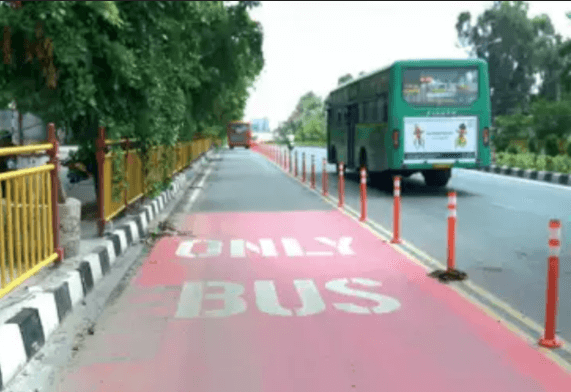In an initiative to curb road accidents and ease traffic congestion in the national capital, the Delhi government on March 23 announced the launch of an intensive “bus lane enforcement drive” for buses and heavy vehicles on 15 selected roads. Violators will be penalised and prosecuted under the provisions of the Motor Vehicles Act, 1988, and Delhi Maintenance and Management of Parking Places Rules, 2019. Vehicles found driving in other lanes would be prosecuted under Section 192-A of the Motor Vehicles Act, 1988, which prescribes a fine of Rs 10,000, and jail up to six months.
Last year, the Public Works Department created dedicated bus lanes and sensitised bus drivers to drive in those lanes only. The PWD has been directed to mark and adequately identify the corridors with long-lasting thermoplastic paints and warning signage and boards at suitable places.
The drive will be executed in Delhi in different phases. In the first phase, the transport department and traffic police will begin the drive from April 1 from 8 am to 10 pm in 15 corridors. There are a total of 46 such corridors where the move will be implemented in a phased manner.
The 15 corridors include Mehrauli-Badarpur Road stretch from Anuvrat Marg T-point to Pul Prahladpur T-point, Jahangirpuri Metro Station-Kashmere Gate ISBT and ITO-Ambedkar Nagar, Moti Nagar to Dwarka Mor, Ashram Chowk to Badarpur Border, Signature Bridge-Bhopura Border, Britannia Chowk to Dhaula Quan, Janakpuri to Madhuban Chowk and Kashmere Gate ISBT to Apsra Border. There are some other roads as well. Almost 150 km of roads will be under the surveillance of the transport department’s enforcement team, which will also include the traffic police.
While buses and heavy vehicles will be allowed only on segregated lanes, other vehicles may be permitted on these dedicated lanes during the remainder of the time (10 pm to 8 am). Both will have to strictly adhere to their dedicated lanes round the clock.
Also Read: Anything for a Clean Sweep
Transport minister Kailash Gahlot tweeted:
“To make Delhi roads safer, the Arvind Kejriwal government is starting Bus Lane Enforcement drives to increase Commuter Safety & tackle congestion. Directions have been issued to DTC & Cluster for driver sensitization, PWD for earmarking bus lanes & Transport, Police enforcement teams.”
The minister told the Delhi Assembly that the transport department will launch the enforcement drive from April 1. He said the traffic police had been asked for an intensive enforcement of the drive and teams of transport department will also be deployed. He further said that the department would also launch a WhatsApp number on which people can send videos of violations by bus drivers. “Bus drivers violating designated lanes on the roads will be slapped with a fine of Rs 10,000 and they face suspension of driving licence, prosecution under the MV Act and cancellation of vehicle permit on repeat offences from April 1,” Gahlot said.
Girish Kumar Dubey, a senior government official in the PWD, said that the lane discipline enforcement drive would be undertaken in accordance with the Supreme Court orders. He said light vehicles like cars may ply on the bus lanes during no entry hours but those obstructing the bus lanes will be towed away. The bus lanes will be used exclusively by buses after lifting of no entry restrictions and if any light motor vehicle is found plying there, it may be challaned, he said.
PWD will be responsible for marking and placing proper boards and signs at the specified corridors where the rule is applicable. If a car is found parked or unattended in the bus lane and if the owner or the driver refuses to remove the vehicle, it will be towed away. The driver/owner would have to pay the towing charges in addition to the penalty.
There will be two teams appointed in two shifts so that lane discipline can be maintained. Cranes would also be on standby for impounding and removal of vehicles obstructing the bus lanes. The police would also take pictures and videos of the vehicles that are blocking the lane as evidence.
Also Read: Supreme Court dismisses Maharashtra plea in Anil Deshmukh case
In European countries like the UK, France and Germany, lanes are used by any vehicle designed to carry more than eight passengers (excluding the driver). Cyclists and sometimes taxis and two-wheeled motor vehicles can normally use bus lanes during the times they are operational. Other vehicles must not use bus lanes during the times they are operational except for loading and unloading (and only if signs alongside the lane do not indicate otherwise).
Abroad, bus lanes are normally signposted with operational times and types of vehicles allowed. If no sign is visible or if no operational times are shown, motorists must assume that the bus lane is operational 24 hours a day. Some bus lanes are reserved for local bus services only which means that tourist coaches, for instance, must not use them. This is normally signposted.
Last year, it was decided by the AAP government that there would be dedicated bus lanes in Delhi so that the traffic can move smoothly. They will also be working on removing illegal parking and encroachments on the bus lanes. The left side of the road will be dedicated to buses.
Delhi already has a dedicated bus lane at BRT but that failed because it was created in the middle of the road due to which traffic jams and accidents were witnessed. But these separate lanes will be developed on existing dedicated bus lanes.
—By Abhilash Kumar Singh and India Legal Bureau


